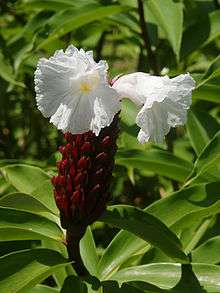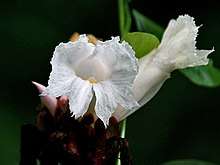Cheilocostus speciosus
| Crêpe ginger | |
|---|---|
 | |
| Cheilocostus speciosus from Tortuguero, Costa Rica | |
_-_Bukidnon%2C_Philippines_01.jpg) | |
| Wild Cheilocostus speciosus from Bukidnon, Philippines | |
| Scientific classification | |
| Kingdom: | Plantae |
| Clade: | Angiosperms |
| Clade: | Monocots |
| Clade: | Commelinids |
| Order: | Zingiberales |
| Family: | Costaceae |
| Genus: | Cheilocostus |
| Species: | C. speciosus |
| Binomial name | |
| Cheilocostus speciosus | |
| Synonyms | |
many more | |
Cheilocostus speciosus, or crêpe ginger, is a species of flowering plants in the genus Cheilocostus. It is native to southeast Asia and surrounding regions, from India to China to Queensland, It is especially common on the Greater Sunda Islands in Indonesia. It is also reportedly naturalized in Mauritius, Réunion, Fiji, Hawaii, Costa Rica, Belize, Melanesia, Micronesia, and the West Indies. It is widely cultivated as an ornamental[2][3]
Description
Cheilocostus speciosus differs from the common ginger by having only one row of spirally arranged leaves. The species reproduces vegetatively by rhizome, and birds disperse the seeds when they feed on the fruits.
This plant is cultivated in South Asia and Southeast Asia for its medicinal uses, and is cultivated elsewhere as an ornamental. In some areas Cheilocostus speciosus is introduced and has become an invasive species.
Habitat
The habitat where this species is found is roadside ditches and low-lying areas in the forest. The flowering season starts after the rainy season, from October to December.
Human relevance
The plant has many historical uses in Ayurveda, where the rhizome has been used to treat fever, rash, asthma, bronchitis, and intestinal worms. It is mentioned in the Kama Sutra as an ingredient in a cosmetic to be used on the eyelashes to increase sexual attractiveness. It is used to treat kidney problems and other urinary problems in Mizo Traditional Medicine. It was used as a traditional medicine by Malays when evil spirits have possessed a body.
Cheilocostus speciosus has a large number of common names in many languages, including isebsab (Palauan); keu, kemuk or keumul (Bengali); keukand (Hindi); thebu (Sinhala); pakarmula (Gujarati); pushkarmula (Marathi and Sanskrit); jom lakhuti (Assamese); kostam (Tamil); Kosta (Kannada); Kostamu (Telugu); sumbul (Mizo); setawar (Malay).
Gallery
 Flower at Kolkata, West Bengal, India.
Flower at Kolkata, West Bengal, India. Flower & leaves at Kolkata, West Bengal, India.
Flower & leaves at Kolkata, West Bengal, India.- Cheilocostus speciosus in Basse Terre, Guadeloupe.
 Cheilocostus speciosus in Hawaii.
Cheilocostus speciosus in Hawaii.
References
- ↑ "Cheilocostus speciosus (J.König) C.Specht". The Plant List. Retrieved 14 July 2013.
- ↑ Kew World Checklist of Selected Plant Families, Hellenia speciosa
- ↑ Pacific Island Invasive Species Archived July 15, 2007, at the Wayback Machine.
External links
| Wikimedia Commons has media related to Cheilocostus speciosus. |